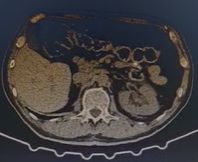Renal Fornix Rupture Due To Acute Ureteral Obstruction
Main Article Content
Abstract
Background: Renal fornix rupture with fluid extravasation is a rare complication in cases of ureteral obstruction, which is usually caused by obstructive ureterolithiasis. The symptoms of renal fornix rupture are not very specific and can easily go unnoticed due to their underlying cause.
Case representation: The present article reports a case of a patient of a 70-year-old, male, who was diagnosed with a ruptured renal fornix due to acute ureteral obstruction, following clinical assessment and a non-contrast CT scan. The proposed course of action was the endoscopic placement of a double J ureteral catheter.
Conclusion: In the case described, the conservative treatment that was chosen by passing a double J catheter through the left ureter, for the patient proved to be an alternative to surgical treatment in the acute event, reducing the risk of possible complications from the operation. It was possible to conclude that although renal fornix rupture is a rare emergency with multiple etiologies, conservative treatment with urinary diversion using a double J ureteral stent was effective in solving the patient's acute condition.
Downloads
Article Details

This work is licensed under a Creative Commons Attribution-NonCommercial-NoDerivatives 4.0 International License.
References
Cabral, E. B., de Almeida, J. L., GUIMARÃES, E. V., & DA PAIXÃO, A. M. L. (2022). Renal fornix rupture with formation of urinanum. Caminhos da Clínica, 1(01).
Larrache, Y., et al. Spontaneous renal forniceal rupture due to a bladder tumor. Urology Case Reports., v. 33, p. 101340, 1 nov. 2020.
Nedjim SA, Abdi M, Al Afifi M, Hagguir H, Mahanna HA, Nachid A, Moataz A, Dakir M, Debbagh A, Aboutaieb R. Spontaneous rupture of the fornix due to a ureteral lithiasis of 3 mm causing a urinoma: report of an original case. Radiol Case Rep. 2021 Aug 5; 16(10):3143-3146. doi: 10.1016/j.radcr.2021.06.065. PMID: 34484508; PMCID: PMC8403901.
Grossmann, N. C., Ardizzone, D., Hermanns, T., Keller, E. X., & Fankhauser, C. D. (2023). Is conservative management safe in patients with acute ureterolithiasis and perirenal stranding?. Urolithiasis, 51(1), 40.
Spinelli, M. G., Palmisano, F., Zanetti, S. P., Boeri, L., Gadda, F., Talso, M., ... & Montanari, E. (2019). Spontaneous upper urinary tract rupture caused by ureteric stones: A prospective high-volume single centre observational study and proposed management. Arch. Esp. Urol, 72(6), 6.
Pampana, E., Altobelli, S., Morini, M., Ricci, A., d'Onofrio, S., & Simonetti, G. (2013). Spontaneous ureteral rupture diagnosis and treatment. Case reports in radiology, 2013.
ERCIL Hakan, TÜMER Erbay, ¸SENTÜRK Aykut Bugra ˘ , et al. Etiology and treatment of renal forniceal rupture: a single center experience. J Urol Surg. 2018; 5(2)):68.
Al-Mujalhem AG, Aziz MS, Sultan MF, Al-Maghraby AM, MA Al-Shazly. Spontaneous forniceal rupture: can it be treated conservatively? Urol Ann. 2017; 9:41–4.
Gershman B, Kulkarni N, Sahani DV, Eisner BH. Causes of renal forniceal rupture. BJU Int. 2011 Dec; 108(11):1909-11; discussion 1912. doi: 10.1111/j.1464-410X.2011.10164.x. Epub 2011 Jul 8. PMID: 21736690.
Coelho RF, Schneider-Monteiro ED, Mesquita JL, Mazzucchi E, Marmo Lucon A, Srougi M. Renal and perinephric abscesses: analysis of 65 consecutive cases. World J Surg. 2007; 31:431–6.
Balsells FS, De Torres Mateos JA, Mas AG, Lopes FG. Physiopathology of spontaneous extravasation of urine in the upper urinary tract. Apropos of 24 cases. J Urol Nephrol 1976; 82:385–95 (Paris).

